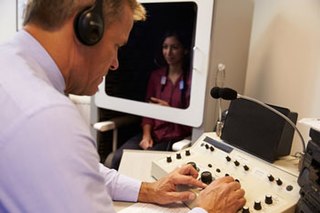 W
WAudiology is a branch of science that studies hearing, balance, and related disorders. Audiologists treat those with hearing loss and proactively prevent related damage. By employing various testing strategies, audiologists aim to determine whether someone has normal sensitivity to sounds. If hearing loss is identified, audiologists determine which portions of hearing are affected, to what degree, and where the lesion causing the hearing loss is found. If an audiologist determines that a hearing loss or vestibular abnormality is present he or she will provide recommendations for interventions or rehabilitation.
 W
WThe acoustic reflex is an involuntary muscle contraction that occurs in the middle ear in response to loud sound stimuli or when the person starts to vocalize.
 W
WAn audiogram is a graph that shows the audible threshold for standardized frequencies as measured by an audiometer. The Y axis represents intensity measured in decibels and the X axis represents frequency measured in hertz. The threshold of hearing is plotted relative to a standardised curve that represents 'normal' hearing, in dB(HL). They are not the same as equal-loudness contours, which are a set of curves representing equal loudness at different levels, as well as at the threshold of hearing, in absolute terms measured in dB SPL.
 W
WAn audiometer is a machine used for evaluating hearing acuity. They usually consist of an embedded hardware unit connected to a pair of headphones and a test subject feedback button, sometimes controlled by a standard PC. Such systems can also be used with bone vibrators, to test conductive hearing mechanisms.
 W
WThe auditory cortex is the part of the temporal lobe that processes auditory information in humans and many other vertebrates. It is a part of the auditory system, performing basic and higher functions in hearing, such as possible relations to language switching. It is located bilaterally, roughly at the upper sides of the temporal lobes – in humans, curving down and onto the medial surface, on the superior temporal plane, within the lateral sulcus and comprising parts of the transverse temporal gyri, and the superior temporal gyrus, including the planum polare and planum temporale.
 W
WThe auditory system is the sensory system for the sense of hearing. It includes both the sensory organs and the auditory parts of the sensory system.
 W
WCholesteatoma is a destructive and expanding growth consisting of keratinizing squamous epithelium in the middle ear and/or mastoid process. Cholesteatomas are not cancerous as the name may suggest, but can cause significant problems because of their erosive and expansile properties. This can result in the destruction of the bones of the middle ear (ossicles), as well as growth through the base of the skull into the brain. They often become infected and can result in chronically draining ears. Treatment almost always consists of surgical removal.
 W
WA cochlear implant (CI) is a surgically implanted neuroprosthetic device to provide a person with moderate to profound sensorineural hearing loss a modified sense of sound. CI bypasses the normal acoustic hearing process to replace it with electric signals which directly stimulate the auditory nerve. A person with a cochlear implant receiving intensive auditory training may learn to interpret those signals as sound and speech. However, one third of deaf children do not develop language if they are on a CI program alone and have no sign language input.
 W
WThe cocktail party effect is the phenomenon of the brain's ability to focus one's auditory attention on a particular stimulus while filtering out a range of other stimuli, as when a partygoer can focus on a single conversation in a noisy room. Listeners have the ability to both segregate different stimuli into different streams, and subsequently decide which streams are most pertinent to them. Thus, it has been proposed that one's sensory memory subconsciously parses all stimuli and identifies discrete pieces of information by classifying them by salience. This effect is what allows most people to "tune into" a single voice and "tune out" all others. This phenomenon is often describes in terms of "selective attention" or "selective hearing". It may also describe a similar phenomenon that occurs when one may immediately detect words of importance originating from unattended stimuli, for instance hearing one's name among a wide range of auditory input.
 W
WCortical deafness is a rare form of sensorineural hearing loss caused by damage to the primary auditory cortex. Cortical deafness is an auditory disorder where the patient is unable to hear sounds but has no apparent damage to the anatomy of the ear, which can be thought of as the combination of auditory verbal agnosia and auditory agnosia. Patients with cortical deafness cannot hear any sounds, that is, they are not aware of sounds including non-speech, voices, and speech sounds. Although patients appear and feel completely deaf, they can still exhibit some reflex responses such as turning their head towards a loud sound.
 W
WThe day–evening–night noise level or Lden is a 2002 European standard to express noise level over an entire day. It imposes a penalty on sound levels during evening and night and it is primarily used for noise assessments of airports, busy main roads, main railway lines and in cities over 100,000 residents. The penalty for sound production during evenings and nights is due to higher nuisance perception during quieter hours and to prevent sleep deprivation for nearby residents.
 W
WIdentification of a hearing loss is usually conducted by a general practitioner medical doctor, otolaryngologist, certified and licensed audiologist, school or industrial audiometrist, or other audiometric technician. Diagnosis of the cause of a hearing loss is carried out by a specialist physician or otorhinolaryngologist.
 W
WHearing, or auditory perception, is the ability to perceive sounds by detecting vibrations, changes in the pressure of the surrounding medium through time, through an organ such as the ear. The academic field concerned with hearing is auditory science.
 W
WHearing conservation programs are designed to prevent hearing loss due to noise. Regarding occupational exposures to noise, a hearing conservation program is required by the Occupational Safety and Health Administration (OSHA) "whenever employee noise exposures equal or exceed an 8-hour time-weighted average sound level (TWA) of 85 decibels (dB) measured on the A scale or, equivalently, a dose of fifty percent." This 8-hour time-weighted average is known as an exposure action value. While the Mine Safety and Health Administration (MSHA) also requires a hearing conservation program, MSHA does not require a written hearing conservation program. MSHA's hearing conservation program requirement can be found in 30 CFR § 62.150, and is very similar to the OSHA hearing conservation program requirements. Therefore, only the OSHA standard 29 CFR 1910.95 will be discussed in detail.
 W
WHyperacusis is a highly debilitating and rare hearing disorder characterized by an increased sensitivity to certain frequencies and volume ranges of sound. A person with severe hyperacusis has difficulty tolerating everyday sounds, which become painful or loud. The prevalence of hyperacusis is 1 in 50,000 people.
 W
WAccording to Oxford Living Dictionaries, to listen is to give attention to sound or action. When listening, one is hearing what others are saying, and trying to understand what it means. The act of listening involves complex affective, cognitive, and behavioral processes. Affective processes include the motivation to listen to others; cognitive processes include attending to, understanding, receiving, and interpreting content and relational messages; and behavioral processes include responding to others with verbal and nonverbal feedback.
 W
WNoise pollution, also known as environmental noise or sound pollution, is the propagation of noise with ranging impacts on the activity of human or animal life, most of them harmful to a degree. The source of outdoor noise worldwide is mainly caused by machines, transport, and propagation systems. Poor urban planning may give rise to noise disintegration or pollution, side-by-side industrial and residential buildings can result in noise pollution in the residential areas. Some of the main sources of noise in residential areas include loud music, transportation, lawn care maintenance, construction, electrical generators, explosions, and people.
 W
WOccupational hearing loss (OHL) is hearing loss that occurs as a result of occupational hazards, such as excessive noise and ototoxic chemicals. Noise is a common workplace hazard, and recognized as the risk factor for noise-induced hearing loss and tinnitus, but it is not the only risk factor that can result in a work-related hearing loss. Also, noise-induced hearing loss can result from exposures that are not restricted to the occupational setting.
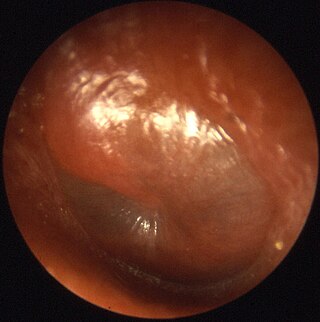 W
WOtitis media is a group of inflammatory diseases of the middle ear. One of the two main types is acute otitis media (AOM), an infection of rapid onset that usually presents with ear pain. In young children this may result in pulling at the ear, increased crying, and poor sleep. Decreased eating and a fever may also be present. The other main type is otitis media with effusion (OME), typically not associated with symptoms, although occasionally a feeling of fullness is described; it is defined as the presence of non-infectious fluid in the middle ear for more than three months. Chronic suppurative otitis media (CSOM) is middle ear inflammation that results in discharge from the ear for more than three months. It may be a complication of acute otitis media. Pain is rarely present. All three types of otitis media may be associated with hearing loss. The hearing loss in OME, due to its chronic nature, may affect a child's ability to learn.
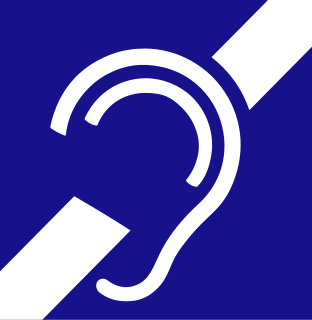 W
WHearing loss is a partial or total inability to hear. Hearing loss may be present at birth or acquired at any time afterwards. Hearing loss may occur in one or both ears. In children, hearing problems can affect the ability to learn spoken language, and in adults it can create difficulties with social interaction and at work. Hearing loss can be temporary or permanent. Hearing loss related to age usually affects both ears and is due to cochlear hair cell loss. In some people, particularly older people, hearing loss can result in loneliness. Deaf people usually have little to no hearing.
 W
WPure tone audiometry or pure-tone audiometry is the main hearing test used to identify hearing threshold levels of an individual, enabling determination of the degree, type and configuration of a hearing loss and thus providing a basis for diagnosis and management. Pure-tone audiometry is a subjective, behavioural measurement of a hearing threshold, as it relies on patient responses to pure tone stimuli. Therefore, pure-tone audiometry is only used on adults and children old enough to cooperate with the test procedure. As with most clinical tests, standardized calibration of the test environment, the equipment and the stimuli is needed before testing proceeds. Pure-tone audiometry only measures audibility thresholds, rather than other aspects of hearing such as sound localization and speech recognition. However, there are benefits to using pure-tone audiometry over other forms of hearing test, such as click auditory brainstem response (ABR). Pure-tone audiometry provides ear specific thresholds, and uses frequency specific pure tones to give place specific responses, so that the configuration of a hearing loss can be identified. As pure-tone audiometry uses both air and bone conduction audiometry, the type of loss can also be identified via the air-bone gap. Although pure-tone audiometry has many clinical benefits, it is not perfect at identifying all losses, such as ‘dead regions’ of the cochlea and neuropathies such as auditory processing disorder (APD). This raises the question of whether or not audiograms accurately predict someone's perceived degree of disability.
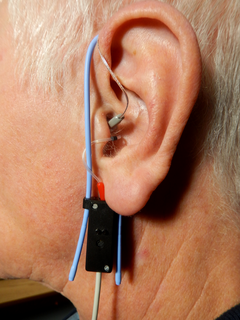 W
WReal ear measurement is the measurement of sound pressure level in a patient's ear canal developed when a hearing aid is worn. It is measured with the use of a silicone probe tube inserted in the canal connected to a microphone outside the ear and is done to verify that the hearing aid is providing suitable amplification for a patient's hearing loss. The American Speech–Language–Hearing Association (ASHA) and American Academy of Audiology (AAA) recommend real ear measures as the preferred method of verifying the performance of hearing aids. Used by audiologists and other hearing healthcare practitioners in the process of hearing aid fitting, real ear measures are the most reliable and efficient method for assessing the benefit provided by the amplification. Measurement of the sound level in the ear canal allows the clinician to make informed judgements on audibility of sound in the ear and the effectiveness of hearing aid treatment.
 W
WThe speech banana is a region in which all the phonemes of the world's languages fall on an audiogram. An audiogram is a graphical representation of a person's hearing acuity at a range of frequencies and loudness levels, and it is generally charted with frequency level (in Hertz on the x-axis and decibel level on the y-axis. When the sounds of speech or phonemes of all known human languages are plotted on an audiogram, they cluster in a banana-shaped region known as the speech banana.
 W
WStenger test is a test of hearing, primarily used to confirm non-organic hearing loss. It is also used to detect subjects who falsely claim to have hearing loss in one ear.
 W
WTinnitus is the perception of sound when no corresponding external sound is present. While often described as a ringing, it may also sound like a clicking, buzzing, hiss, or roaring. The sound may be soft or loud, low or high pitched, and often appears to be coming from one or both ears or from the head itself. In some people, the sound may interfere with concentration and in some cases it is associated with anxiety and depression. Tinnitus is usually associated with some degree of hearing loss and with decreased understanding in noise. It is common, affecting about 10–15% of people. Most, however, tolerate it well, and it is a significant problem in only 1–2% of people. The word tinnitus comes from the Latin tinnire which means "to ring".
 W
WTympanostomy tube, also known as a grommet or myringotomy tube, is a small tube inserted into the eardrum in order to keep the middle ear aerated for a prolonged period of time, and to prevent the accumulation of fluid in the middle ear. The operation to insert the tube involves a myringotomy and is performed under local or general anesthesia. The tube itself is made in a variety of designs. The most commonly used type is shaped like a grommet. When it is necessary to keep the middle ear ventilated for a very long period, a "T"-shaped tube may be used, as these "T-tubes" can stay in place for 2–4 years. Materials used to construct the tube are most often plastics such as silicone or Teflon. Stainless steel tubes exist, but are no longer in frequent use.
 W
WUniversal neonatal hearing screening (UNHS), also known as early hearing detection and intervention (EHDI) programs in several countries, refer to those services aimed at the early identification, intervention, and follow-up of infants and young children who are deaf or hard-of-hearing. It is a strategy for early detection of permanent congenital hearing loss. It describes the use of objective testing methods to screen the hearing of well newborns in a particular target region.
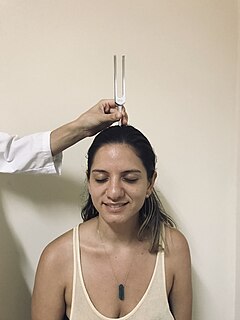 W
WThe Weber test is a screening test for hearing performed with a tuning fork. It can detect unilateral (one-sided) conductive hearing loss and unilateral sensorineural hearing loss. The test is named after Ernst Heinrich Weber (1795–1878). Conductive hearing ability is mediated by the middle ear composed of the ossicles: the malleus, the incus, and the stapes. Sensorineural hearing ability is mediated by the inner ear composed of the cochlea with its internal basilar membrane and attached cochlear nerve. The outer ear consisting of the pinna, ear canal, and ear drum or tympanic membrane transmits sounds to the middle ear but does not contribute to the conduction or sensorineural hearing ability save for hearing transmissions limited by cerumen impaction.
 W
WWorld Hearing Day is a campaign held each year by Office of Prevention of Blindness and Deafness of the World Health Organization (WHO). Activities take place across the globe and an event is hosted at the World Health Organization on March 3rd. The campaign's objectives are to share information and promote actions towards the prevention of hearing loss and improved hearing care. The first event was held in 2007. Before 2016 it was known as International Ear Care Day. Each year, the WHO selects a theme, develops educational materials, and makes these freely available in several languages. It also coordinates and reports on events around the globe.